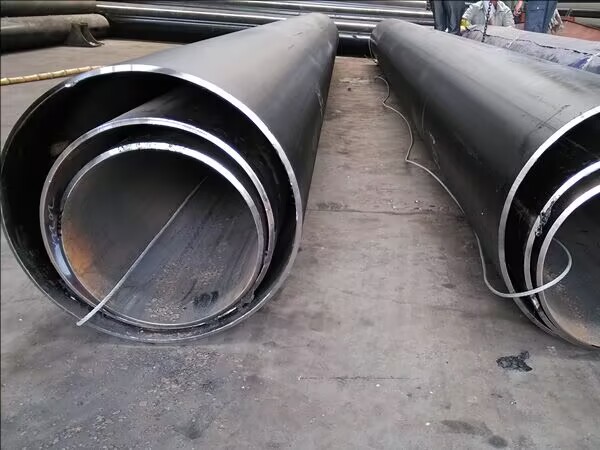ERW (Electric Resistance Welded) pipes and
LSAW (Longitudinal Submerged Arc Welding) pipes are both common carbon steel welded pipes. However, there are significant differences in the form of raw materials, welding methods, size ranges, mechanical properties and application fields.
ERW tube (Electric Resistance Welded)
ERW pipes are cold-formed from hot-rolled steel coils and formed by high-frequency resistance heating and welding. They feature high production efficiency and low cost, and are often used in medium and small diameter structures as well as low-pressure fluid transportation scenarios. LSAW pipes are made from steel plates. After being formed by UOE or JCOE, they undergo inner and outer double-sided submerged arc welding. They can be used to manufacture large-diameter, thick-walled and high-pressure grade pipes, and are widely used in long-distance oil and gas transportation, offshore platforms and major infrastructure.

Main features
Raw materials and costs: Using continuous steel coils as raw materials, the equipment investment and energy consumption are relatively low, suitable for large-scale and standard-specification production, and the cost per ton is lower than that of seamless pipes.
Size range: The common outer diameter is 0.5" to 24" (approximately 21.3-609.6mm), and the wall thickness is 1.65-20mm. The length and end form can be customized according to requirements.
Mechanical properties: The metal loss and heat-affected zone at the weld seam make its toughness slightly lower than that of submerged arc welding or seamless pipes, but it has sufficient strength and reliability in low-pressure (≤30 MPa) and general structural applications.
Production efficiency: Continuous rolling and high-speed forming and welding (the production line speed can reach over 60 m/min), with extremely high production efficiency, suitable for large-scale supply.
Typical applications
Structural pipes: scaffolding, railings, mechanical frames, etc.
Low-pressure fluid transportation: municipal water supply and drainage, gas pipelines, HVAC pipelines;
General mechanical pipe fittings: hydraulic sleeves, automotive exhaust pipes, etc.
LSAW pipe (Longitudinal Submerged Arc Welding)
LSAW tubes, also known as SAWL (Submerged Arc Welded Longitudinal), are formed by two main processes: UOE and JCOE.
UOE method: The steel plate is first pre-bent in a U shape, then the C shape and O shape are finally formed into a ring, and then double-sided submerged arc welding is carried out on the inside and outside of the pipe.
The JCOE method: After the steel plate is formed three times by J, C and O respectively, the inner and outer submerged arc welding is carried out, which results in higher processing accuracy and is suitable for the manufacturing of super-large diameter pipes.
The finished pipes still need to undergo diameter expansion and straightening, heat treatment and strict non-destructive testing to ensure that the welds and the base structure are dense and defect-free.
Main features
Raw materials and dimensions: Using wide and thick steel plates as raw materials, we can produce pipes with diameters ranging from 219 to 2500 mm and above, and wall thicknesses up to 40 mm or more, meeting the demands of large-scale long-distance and high-pressure pipelines.
Weld quality: The inner and outer double-sided submerged arc welding creates a high-strength weld with deep penetration, a narrow heat-affected zone, and low residual stress, featuring excellent impact toughness and fatigue life.
Mechanical properties: High longitudinal and circumferential tensile strength, strong resistance to internal pressure leakage, corrosion and crack propagation, suitable for high pressure (up to over 100 MPa), Sour service and Marine environments.
Production efficiency: Although the forming and welding speed (about 4 m/min) is lower than ERW, it still has an economic advantage over large-diameter pipelines due to the high utilization rate of sheet materials and less subsequent processing.
Typical applications
Long-distance oil and gas pipelines and intercity gas pipelines
Offshore platforms and deepwater pipelines
High-pressure water supply, industrial pipelines, and infrastructure pile pipes such as Bridges and docks.
